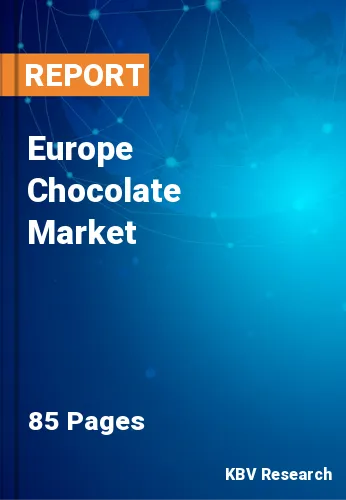The Europe Chocolate Market would witness market growth of 5.1% CAGR during the forecast period (2020-2026). The European chocolate industry is projected to rise marginally more than the global demand. The growth of the market is likely to be guided by increased preferences for dark chocolate. Dark chocolate provides advantages such as helping to improve cardiovascular health, blood pressure, and cognitive function.
Demand for industrial chocolate is also rising at a steady pace. The European region would be a key market for manufacturing chocolate and the major consumers are likely to rise from countries such as Germany, Belgium, and France. The growing demand for dark chocolate as an active ingredient in many end-user industries is driving the growth of the industrial chocolate market in the area. With the growing demand for milk-free food products from customers in this area, industrial chocolate producers are also focused on increasing their milk-free product offerings in Europe.
Switzerland is renowned for its chocolates and major producers of chocolate. Chocolate development is a big cause of the country's income. The cornerstone of Zurich 's chocolate development is often regarded. Nestle, Toblerone, Lindt, and Sprungli are world-renowned chocolate brands originating in Switzerland.
Belgium, which is also renowned internationally for its chocolates, is a global hub for the manufacture of chocolate. In Belgium there are about 15 chocolate factories and over 2,000 chocolate shops. Godiva is one of the world's best-known chocolate companies and is based in Brussels.
Belgian law mandates that a minimum of 35% pure cocoa will be used in production in order to guarantee the pureness of chocolate and to avoid the loss of quality fat from sources outside. The chocolate industry and the country's interest in the production process and the subsequent commodity contributes to conventional processing techniques. This includes a ban against fats derived from artificial, vegetable or palm oil in all products labeled with "Belgian chocolate". A large part of chocolate companies in Belgium primarily makes chocolate by hand, without the aid of modern production facilities.
Based on Product, the market is segmented into Traditional Chocolate and Artificial Chocolate. Based on Traditional Chocolate Type, the market is segmented into Milk Chocolate, Dark Chocolate and White Chocolate. Based on Distribution Channel, the market is segmented into Supermarket & Hypermarket, Convenience Store and Online. Based on countries, the market is segmented into Germany, UK, France, Russia, Spain, Italy, and Rest of Europe.
Free Valuable Insights: Chocolate Market in Europe is expected to register a CAGR of 5.1% during the forecast period (2020-2026)
The market research report covers theanalysis of key stake holders of the market. Key companies profiled in the report include Nestle S.A., Mondelez International, Inc., The Hershey Company (Hershey Trust Company), Mars, Inc., The Barry Callebaut Group, Meiji Holdings Co., Ltd., Ferrero International S.A., Lindt & Sprungli AG, Moonstruck Chocolate Company, and Yildiz Holdings A.S.
Market Segmentation:
By Product
By Traditional Chocolate Type
By Distribution Channel
By Country
Companies Profiled
Our team of dedicated experts can provide you with attractive expansion opportunities for your business.

